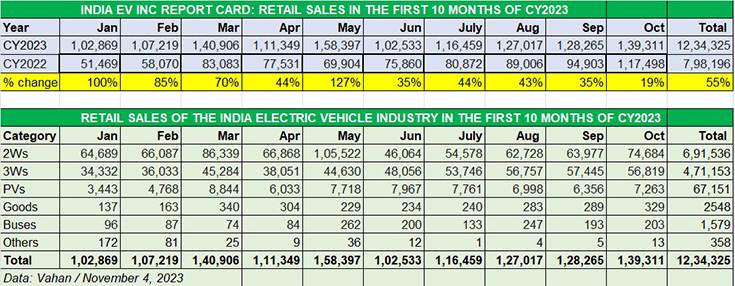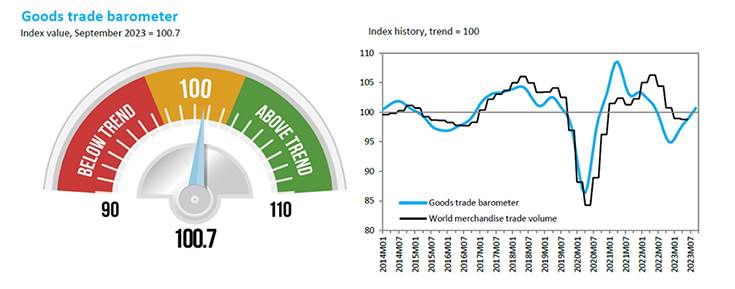The latest quarterly WTO Goods Trade Barometer, released by the World Trade Organisation (WTO) on November 27, indicates that the volume of global merchandise trade is recovering after its recent slump, with automobile sales and production and electronic components trade driving the recovery. However, mixed economic results coupled with increasing geopolitical tensions make the near-term outlook highly uncertain.
As per the global trade body, the current reading of 100.7 for the barometer index is above the previous reading of 99.1 from August 2022 and close to the baseline value of 100. This suggests that merchandise trade volume will gradually revert towards its medium-term trend in the second half of 2023, although uncertainty remains high due to mixed economic data and rising geopolitical tensions.
The WTO Goods Trade Barometer’s component indices are mixed, with some rising firmly above trend and others remaining on or below trend. The biggest gains were seen in the indices for automobile sales and production (110.0) and electronic components trade (109.8). The indices for air freight (100.3), export orders (99.4) and container shipping (98.0) finished on or slightly below trend, while the raw materials index (95.6) sank below trend.

Current reading of 100.7 for the WTO barometer index is above the previous reading of 99.1 from last August and close to the baseline value of 100, suggesting that merchandise trade volume will gradually revert towards its medium-term trend in the second half of 2023 albeit uncertainty remains high due to mixed economic data and rising geopolitical tensions. (Data: WTO)

Automotive best-performing (110), closely followed by electronic components (109.8). WTO says this is thanks to surging global demand for EVs.
Data: WTO
“The strength of the automotive products and electronic components indices may be explained by surging global demand for electric vehicles, while the weak result for raw materials may be partly due to weakening property markets as interest rates remain elevated,” said WTO.
India among fastest growing global EV markets
In Europe, the demand for electric vehicles continues to be high despite the lack of affordable EVs on the market. According to JATO Dynamics, in September 2023, EV sales totalled 186,380 units and accounted for 16.1% of the market – an increase of 13% when compared to September 2022. Between January and September 2023, , a total of 1,465,249 new electric passenger cars have been registered in Europe, marking a 47% increase when compared with the same period last year.
India is among the fastest growing global markets for EVs. Cumulative EV industry sales, comprising the two- and three-wheeler, passenger vehicle and commercial vehicle sub-segments, for the first 10 months of 2023 are 12,34,325 units, which constitutes strong 55% year-on-year growth (January-October 2022: 798,196 units).
November 2023 is the 14th month in a row that India EV Inc has surpassed the 100,000-unit sales mark. As of November 28, total EV retails in India were 124,581 units with three days still to go for the month to end. Having first notched the milestone in October 2022 (117,200 units), the sales momentum continued in November (121,602 units) and December (105,003 units) last year and through each of the first 10 months of CY2023, hitting a high in May 2023 (158,397 units) when e-two-wheeler buyers rushed to buy EVs before the slashed FAME subsidy kicked in from June 1, 2023.

Total EV sales in India surpassed the 3-million units mark in end-October 2023. The past two years have witnessed accelerated growth– annual sales grew by 209% in CY2022 to charge past the 1-million-unit mark for the first time. CY2023 took off where CY2022 ended, and the million sales milestone was surpassed in September 2023 itself. CY2023 should see total EV sales of nearly 1.5 million units, led by the two- and three-wheeler segments.
Q3 trade should be stronger with accelerating GDP growth in US, China
The Goods Trade Barometer is a composite leading indicator for world trade, providing real-time information on the trajectory of merchandise trade relative to recent trends. Barometer values greater than 100 are associated with above-trend trade volumes while barometer values less than 100 suggest that goods trade has either fallen below trend or will do so in the near future.
As per WTO, world merchandise trade volume was flat in the second quarter of 2023, up 0.2% compared to the previous quarter but still down 0.5% year-on-year. Trade statistics for the third quarter should come in slightly stronger thanks to accelerating GDP growth in the United States and China, even as a stagnant European Union economy continued to weigh on global demand.
Year-on-year trade growth is likely to be strong in Q4 in any case due to the reduced amount of trade in the same period last year as high energy prices, rising interest rates and pandemic-related disruptions weighed on economic growth in leading economies. These developments are consistent with the WTO’s forecast of October 5, 2023, which foresaw an 0.8% increase in global trade volume in 2023. While the forecast remains unchanged, risks to the trade outlook have shifted towards the downside in light of recent developments in the Middle East.
